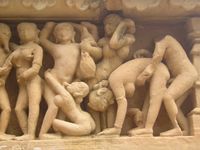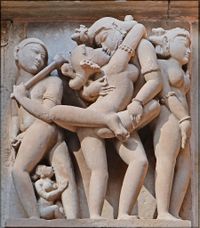الجنسانية في الهند
Multicultural India has developed its discourse on sexuality differently based on its distinct regions with their own unique cultures. However, one common aspect remains: the existence of a subtle conspiracy of silence and taboos that clouds the Indian world of sexual desires and expressions. The origins of this silence towards India's rich contributions to sexuality and shunning of it almost are to be found in the repercussions of the colonial rule and of the Bible. [1] This shaped the attitude and opinions Indian people hold about their sexuality today; one that is hegemonically heterosexual and must aim at procreation after marriage. However, from the second half of the 20th century, several significant voices have challenged this silence imposed over sexuality and questioned the roles assigned to desires within the socio-political and artistic fields. Many recently published studies confirm the richness of India's erotic past and popular voices are now spotlighting this for the masses to know. A myriad of folk tales,[2] sculptures like those in Khajuraho,[3][4] religious poetry[5] and scholary documents[6] reveal homoerotic content and how love and sex between women, men, gods, semi-gods and goddesses was expressed.
خلفية
العصور القديمة
الفترة الاستعمارية

القضايا الحالية
الإعلام الحديث
الجنسانية في الترفيه الشعبي
الإباحية
صناعة الجنس
انظر أيضاً
- تاريخ الجنسانية البشرية
- الهندوسية والتوجه الجنسي
- المثلية الجنسية في الهند
- المثلية الجنسية والهندوسية
- المثلية الجنسية والسيخية
- كاما سوترا
- المفاهيم الغير غربية عن الجنسانية الذكورية
المصادر
- ^ García-Arroya, Ana. First Indian Reprint: 2010, Alternative Sexualities in India.
- ^ Pattanaik, Devdutt. 2002. The Man Who Was A Woman And Other Queer Tales.
- ^ LINGIS, ALPHONSO. "KHAJURAHO." Soundings: An Interdisciplinary Journal, vol. 62, no. 1, 1979, pp. 52–69. https://www.jstor.org/stable/41178110.
- ^ Allen, James Sloan. "The Mystery of the Smiling Elephant: In the Erotic Temples of Khajuraho." The Georgia Review, vol. 53, no. 2, 1999, pp. 321–340. https://www.jstor.org/stable/41401706.
- ^ Kidwai, Saleem and Vanita, Ruth. 2000. In Same-Sex Love in India
- ^ Thadani, Giti. 1996. Sakhiyani:Lesbian Desire in Ancient and Modern India
قراءات إضافية
- Alain Daniélou. The Complete Kama Sutra: The First Unabridged Modern Translation of the Classic Indian Text. Inner Traditions,1993 ISBN 0-89281-525-6.
- Doniger, Wendy. "The Mare's Trap, Nature and Culture in The Kama Sutra." Speaking Tiger, 2015. ISBN 978-93-85288-06-7.
- The Continent of Circe by Nirad C. Chaudhuri – this has a chapter devoted to the topic.
- CIOTTI, MANUELA. "'The Bourgeois Woman and the Half-Naked One': Or the Indian Nation's Contradictions Personified." Modern Asian Studies, vol. 44, no. 4, 2010, pp. 785–815. www.jstor.org/stable/40664946.
- Rao, Vidya. "‘Thumri’ as Feminine Voice." Economic and Political Weekly, vol. 25, no. 17, 1990, pp. WS31–WS39. www.jstor.org/stable/4396223.
- Tripathi, Laxminarayan. "Me Hijra, Me Laxmi." Oxford University Press, 2015. ISBN 9780199458264. Translated from the Marathi original by R. Raj Rao and P. G. Joshi.
- Revathi, A. "The Truth About Me, A Hijra Life Story." Penguin Books, India, 2010. ISBN 9780143068365. Translated from Tamil by V. Geetha.
- Vanita, Ruth. "love's rite, Same-Sex marriage in India and The West.". Palgrave Macmillan, 2005. ISBN 9781403981608.
- Narrain, Arvind. "Queer." BOOKS for CHANGE, 2004. ISBN 81 -87380 - 91 -8
- Parkinson, R.B. . "A Little Gay History." The British Museum Press, 2013. ISBN 978-0-231-16663-8.
- Edited by Sangari, Kumkum and Vaid, Sudesh. "Recasting Women, Essays in Colonial History." Zubaan Publishers Pvt. Ltd., 2003. ISBN 978-93-84757-73-1.
- Edited by Dasgupta, Rohit and Gokulsing, K. Moti. "Masculinity and Its Challenges in India." Mcfarland & Company, Inc., Publishers. 2041. ISBN 978-0-7864-7224-6.
- Alhuwalia, Sajam. "Rethinking Boundaries: Global and the Local in the History of Birth Control: an Indian Case Study," orig. in Journal of Women's History, 14: 4(2003); reprinted in Sue Morgan, ed., The Feminist History Reader (2006)
- Alhuwalia, Sajam."Demographic Rhetoric and Sexual Surveillance: Indian Middle Class Advocates of Birth Control, 1847-1947," in J. Mills and Satadru Sen, eds. Confronting the Body: The politics of Physicality in Colonial and Post-Colonial India (2003)
- Alhuwalia, Sajam."Sex and Reproduction: Politics of Birth Control in Colonial India.1920-1947. Indian Journal of Gender Studies. 2012.
وصلات خارجية
- * BBC Article on AIDS Awareness in India
- Indian Sex Life Survey - Average Ages, Statistics on Foreplay, Intercourse & Frequency, Extramarital & Premarital Data, Homosexuality in Indian Society and other such related issues
- History of Sex: Ancient India
- IASSTD & AIDS - Indian Association for the Study of Sexually Transmitted Diseases & AIDS
- India In World Sex Survey - Frequency of sex in India & other data
- The Pink Panties Campaign: The Indian Women's Sexual Revolution. Intersections: Gender and Sexuality in Asia and the Pacific Issue 23, January 2010



